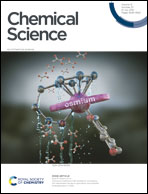[GaF(H2O)][IO3F]: a promising NLO material obtained by anisotropic polycation substitution†
Abstract
A novel salt-inclusion fluoroiodate [GaF(H2O)][IO3F] derived from CsIO2F2 was ingeniously obtained through anisotropic polycation substitution. Because the catenulate [GaF(H2O)]2+ framework serves as a template for the favorable assembly of the polar [IO3F]2− groups and contributes to the nonlinear coefficient, [GaF(H2O)][IO3F] exhibits a greatly improved second-harmonic generation (SHG) effect of 10 times that of KH2PO4 (KDP) and a considerable band gap of 4.34 eV compared to the parent compound CsIO2F2 (3 × KDP, 4.5 eV). Particularly, to the best of our knowledge, [GaF(H2O)][IO3F] has the largest laser-induced damage threshold (LDT) of 140 × AgGgS2 of the reported iodates. All these results signify that [GaF(H2O)][IO3F] is a promising nonlinear optical (NLO) crystal. This work also proposes that anisotropic polycation substitution is an effective approach to optimize the SHG effect and develop excellent NLO materials.
![Graphical abstract: [GaF(H2O)][IO3F]: a promising NLO material obtained by anisotropic polycation substitution](/en/Image/Get?imageInfo.ImageType=GA&imageInfo.ImageIdentifier.ManuscriptID=D1SC01401C&imageInfo.ImageIdentifier.Year=2021)
- This article is part of the themed collection: 2021 Chemical Science HOT Article Collection


 Please wait while we load your content...
Please wait while we load your content...